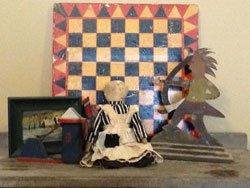|
American Folk Art Collections
 In last month’s newsletter we explored the definition of American folk art, especially as it compares to fine art. This month we will explore the types of artifacts that broadly fall into the folk art category. In last month’s newsletter we explored the definition of American folk art, especially as it compares to fine art. This month we will explore the types of artifacts that broadly fall into the folk art category.
The comparison between folk and fine art is especially evident in paintings. The “naïve” or lack of realistic quality of the portraits, landscapes, still life and other paintings are highly sought after. Contrary to popular notion started in the 1920-30s, a number of folk art painters have been identified including John Singleton Copley, John Trumbull, Benjamin West, Winthrop Chandler, John Brewster, Sheldon Peck and many others. Paintings that can be attributed to a known folk artist command premium dollars. But, it is quite possible to collect folk art paintings of many of the unknown artists for reasonable prices.
Beyond paintings, the number of categories of folk art is wide. Weathervanes, whirligigs, decoys, gameboards, scrimshaw, canes, and toys are just some examples of folk art. They can be made from wood, metal, stone and bone – the material is not the deciding factor but rather the form/decoration of the piece.
An ordinary bowl, box, chest, mold, jug or other container becomes folk art as soon as it is decorated or carved. For example, a decorated blanket chest becomes not just a piece of furniture but folk art. Just about anything that was carved could be considered folk art: wooden birds, powder horns, tramp art, “prison art” (ivory & bone), and “sailor art” (ditty boxes, shell art, scrimshaw) are other examples.
Textiles can also be considered folk art. In this category we have quilts, hooked rugs, coverlets, cloth rag dolls and toys, samplers, theorems and even potholders. Wallpapered band and hat boxes can also be considered folk art.
Search for lots more folk art on Dig Antiques.
References:
|
|
Leave It Alone
Written by Guest Columnist: Lyn Andeen
There seems to be a trend on television shows to repurpose and reinvent old objects.
In some cases, objects destined for the trash heap are transformed into "folk art" or a useful purpose. This pursuit has its merits.
I take objection however with shows that set people loose at flea markets and garage/estate sales that advocate transforming an antique into something else. I even saw a 19 c tilt top table have its top taken off and a hideous black and silver mirror put on the top. To add insult to injury they sold this horrid piece and then were rewarded by the show for making the most profit. I also recently saw someone paint a beautiful Empire chest. Luckily they liked its intricate glass knobs and put them back on.
Restoration of old pieces is sometimes necessary, but this is out and out destruction.
Why can’t they see the beauty in an antique in its original state? Advocating destroying an antique almost verges on criminal.
Let’s hear your take on this new trend. How do you feel? Please post on the Dig Antiques Facebook page and let’s continue the conversation!
About Lyn Andeen
Lyn Andeen has been an avid collector and dealer for the past 28 years. She has been in group shops, setup at countless antique shows and has a true artistic eye. Lyn's passion is for quality 18th through early 20th century Americana, decorative arts, Shaker and folk art. You can find Lyn online through Andeen Antiques.
|
|
Seeing the Impact
We are in the middle of our annual driving trip from California to New York. The first few times, we always found the trip exciting. Now, we can anticipate what is coming making it a bit less interesting. However, there is always something new to see. Yesterday we drove through El Reno, OK on I-40. We didn't leave the highway or even slow down, but we could see the evidence of the horrible tornado that struck. For two miles (at least) we could see debris in piles in fields on the side of the highway. Each pile was indistinguishable - some mix of metal, paper and cloth. There was a section of trees down on both sides of the highway. The sheer destruction took our breath away. Photos and videos don't have the same impact as driving past where you can experience the magnitude of the area impacted... and we only saw a tiny fraction of it. Our hearts go out to those that were affected.
Vermont Antique Dealers Association Antique Show
We hope you will be able to stop by and visit with us at the Vermont Antique Dealers Association (VADA) Antiques Show on July 27-28. This will be the first time that we are exhibiting at this show. Stop in and see us and pick up your Dig Antiques reusable shopping tote!!
Tell Us What You Think
We are continuing our dialog on our Facebook page. How do you feel about taking antiques and significantly changing the original finish and/or character of the antique? Is this a way of "updating" them or "destroying" them? Do join in the discussion!
Sincerely,
Tom & Sheila Baker
diginfo@digantiques.com
We Dig It...do you? Dig Antiques - Real stuff without the fluff.
 
|

 In
In